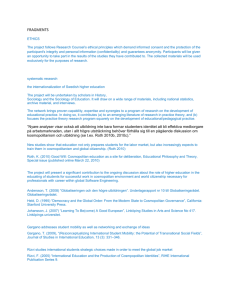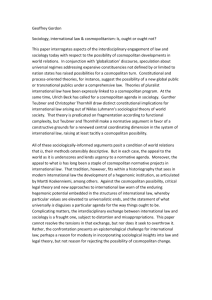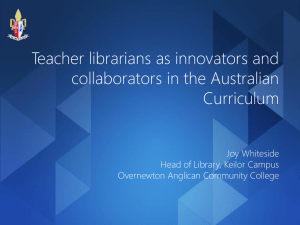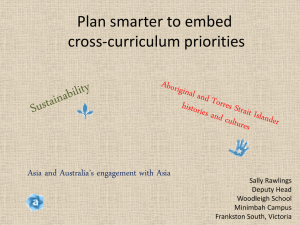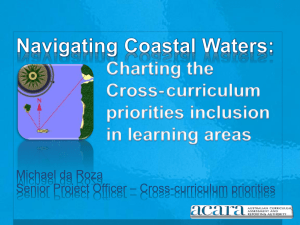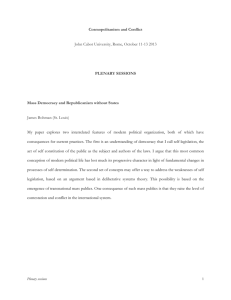PowerPoint - Australian Curriculum Studies Association
advertisement
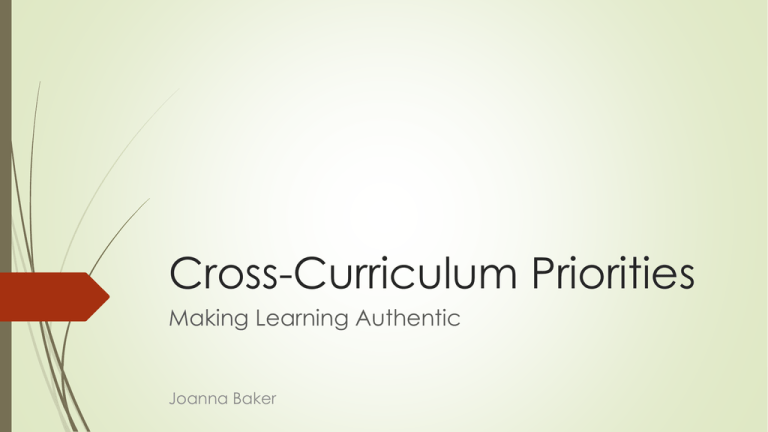
Cross-Curriculum Priorities Making Learning Authentic Joanna Baker About me… • Teacher • Traveller About you: • Role? • Interests? • Questions about the AC priorities? This Workshop: We will explore the challenges and opportunities presented by the AC Cross-Curriculum Priorities 1. Why the Cross-Curriculum Priorities? How are they relevant to English? 2. What is a cosmopolitan approach to learning? 3. Examples of a cosmopolitan approach to the three priorities. 4. Discussion and sharing of ideas. Takeaways: A framework for designing tasks and units in English which emphasizes situated, networked learning. Examples of English tasks and activities that align with the Cross-Curriculum Priorities and can be immediately implemented. A deeper understanding of cosmopolitan learning and its broader implications for education. Aboriginal and Torres Strait Islander histories and cultures What ACARA says: All students will develop an awareness and appreciation of, and respect for the literature of Aboriginal and Torres Strait Islander Peoples including storytelling traditions (oral narrative) as well as contemporary literature. Students will be taught to develop respectful critical understandings of the social, historical and cultural contexts associated with different uses of language and textual features. Asia and Australia’s engagement with Asia What ACARA says: The Australian Curriculum: English enables students to explore and appreciate the rich tradition of texts from and about the peoples and countries of Asia, including texts written by Asian Australians. They develop an understanding of the many languages used in Australia and how they have influenced Australian culture. In this learning area, students develop communication skills that reflect cultural awareness and intercultural understanding. Sustainability What ACARA says: The Australian Curriculum: English provides students with the skills required to investigate and understand issues of environmental and social sustainability; communicate information about sustainability, and advocate action to improve sustainability. English provides an important means of influencing behaviours, facilitating interaction and expressing viewpoints through the creation of texts for a range of purposes, audiences and contexts including multimodal texts and the use of visual language. What are your concerns about implementing the three priorities in English? Discussion: Why these priorities? Why now? What are we asking young people to be able to do in the 21st century? What experiences at school will build their confidence and capacity to DO those things? What opportunities does schooling provide for learning as doing? Melbourne Declaration goals Australian Curriculum General Capabilities Education in transnational spaces Transnationalism = the dynamic processes through which knowledge, identities and cultures are constructed across borders (Vertovec, 2001) Language and dialogue is the primary medium for these processes (Luke, 2004) A type of ‘complex connectivity’: inter-connectedness as a socio-cultural and psycho-social condition (Tomlinson, cited in Rizvi 2009). Dynamic: cultures are continuously emerging and transforming, created and re-created (Rizvi, 2011) Cosmopolitanism as an educational ideal PEDAGOGICAL DIMENSION ETHICAL DIMENSION A way of learning about, and participating in, An ethical framework for negotiating new transnational social formations and the transnational spaces, valuing democracy, ways in which knowledge, identities and cultures equality and respect for difference. are constructed. Emphasises the authentic: Instead of learning concepts and ideas in the abstract, students learn through contextualized, purposeful activity and interaction. Emphasises a relational understanding of the ‘self’: students are able to critically examine the dynamic interplay of the personal, social, global ‘imagination’ in the formation of their own subjectivity (Appadurai, 1996) Situated Interactive Cosmopolitan learning is… Purposeful Authentic What types of knowledge and skills are we developing in a cosmopolitan English classroom? Knowledge Where would you go to source knowledge on the three AC priorities? Cosmopolitanism (transnationalism) posits that knowledge is distributed, and thus dynamic; that it is not held but rather coconstructed. Knowledge is created and recreated through networks; communities of knowledge/learning/practice How are we using these networks in the classroom? How might they be used? An example from the English classroom: Indigenous perspectives Task: Students explore the various forms of oral storytelling that are integral to Australian Indigenous cultures. They research how and why oral traditions have developed and endured, as well as the various types of oral stories. Students may then compare oral storytelling practices across cultures, or compare traditional and modern oral storytelling forms within their community context. Assessment: presentation of research in any format (website, video, live presentation), or a written report/essay. What makes it cosmopolitan? The real-world ‘problem’: How cultural practices evolve according to time and place. The knowledge networks: Academic researchers; local and international indigenous communities An example from the English classroom: Asia Task: Students create (digital) storybooks for English Second Language learners. Working with a partner school in Asia, or with ESL students in their own community, students research the key language challenges these students face through interviews and evaluation of existing texts. Assessment: The completed storybook What makes it cosmopolitan? The knowledge networks: ESL students in Asia; professional creative writers and publishers. The real-world ‘problem’: How ESL learners from particular linguistic backgrounds can improve their skills through reading stories. An example from the English classroom: Sustainability Task: Students select a current sustainability issue (eg. carbon pricing) and create a campaign around this issue. Students research their issue and develop a position, design an advertising campaign targeted at a specific audience, create a website to support their campaign, and present a persuasive speech to their peers. Assessment: Any or all elements of the campaign. What makes it cosmopolitan? The knowledge networks: Researchers in sustainability and related sciences; activist organisations. The real-world ‘problem’: How can we use the techniques of persuasion to promote action on important environmental and social issues? Skills What types of skills do students need in order to navigate and make meaning of transnational spaces? AC General capabiltiies/21C skills project In English? How do you teach to develop these at the moment? Cosmopolitan approach: an emphasis on interaction to make meaning Encountering new/conflicting ways of seeing the world generates creativity and critical thinking (Luke, 2004) Developing skills in the English classroom What capabilities do we think students need in the 21st century? research processes: seeking, comprehending, evaluating and synthesizing information. creative application of knowledge to solve problems and achieve specific goals intercultural competencies collaboration written and oral communication for various contemporary purposes, audiences and contexts Discussion: Pros/cons of this approach as you understand it Ideas for connecting classrooms with knowledge networks, at a local/regional/global level. So why cosmopolitan learning in English? Networked learning is already going on students do it every day! We need to use the power of connectivity to make meaningful connections – to make English learning relevant, purposeful and useful for our students. Online resources for the priorities Joanna Baker ATSI Histories and Cultures: QSA resources on oral traditions, indigenous spirituality, and ethical research in indigenous studies. Asia and Australia’s Engagement with Asia Asia Literacy Ambassador Project Asia Education Foundation AC resources for English Texts related to Identity: Intersections of Identity Sustainability NDLRM Sustainability Resources Sustainability Unit for English Further reading Transnationalism and Cosmopolitan Learning: Rizvi, Teaching Global Interconnectivity Rizvi, Towards Cosmopolitan Learning Experience and education (learning as doing): Dewey, Experience and Education Networked Learning: Downes, Learning networks and connective knowledge References Appadurai, A. (1996). Modernity at large: Cultural dimensions of globalization (Vol. 1). Minnesota: University of Minnesota Press. Australian Curriculum, Assessment and Reporting Authority. (2013a). General capabilities in the Australian curriculum. Retrieved from http://www.australiancurriculum.edu.au/GeneralCapabilities/Overview/General-capabilities-in-theAustralian-Curriculum. Australian Curriculum, Assessment and Reporting Authority. (2013b). Cross-curriculum priorities. Retrieved from http://www.australiancurriculum.edu.au/crosscurriculumpriorities. Luke, A. (2004). Teaching after the market: From commodity to cosmopolitan. Teachers College Record, 106(7), 1422-1443 Herrington, J., & Oliver, R. (2000). An instructional design framework for authentic learning environments. Educational Technology Research and Development, 48(3), 23-48. Rizvi, F. (2009). Towards cosmopolitan learning. Discourse: Studies in the Cultural Politics of Education, 30(3), 253-268. Retrieved from http://repository.unimelb.edu.au.ezp.lib.unimelb.edu.au/10187/14831. Rizvi, F. (2011). Experiences of cultural diversity in the context of an emergent transnationalism. European Educational Research Journal, 10(2), 180-188. Retrieved from http://dx.doi.org.ezp.lib.unimelb.edu.au/10.2304/eerj.2011.10.2.180. Vertovec, S. (2001). Transnationalism and identity. Journal Of Ethnic & Migration Studies, 27(4), 573582. doi:10.1080/13691830120090386.
